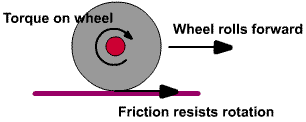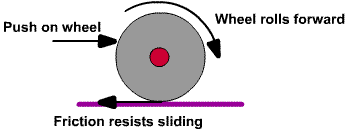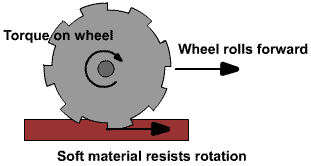|
When a force is applied to a ball or
wheel, it will start rolling, provided there is a
resistive force preventing the wheel from simply sliding
along the other surface. The force may be a torque
applied to the axle of the wheel or a linear push or
pull on the wheel. The resistance of static friction
causes the rolling motion. If the wheel or tire has
treads and the other surface is soft, then those treads
provide extra friction known as traction.
Note that the friction required to start
rolling motion is not rolling friction, which is defined
as the friction slowing down rolling motion.
Questions you may have are:
-
How does friction cause rolling when
torque is applied?
-
How does friction rolling when a
push is applied?
-
What role do treads have in starting
rolling in soft materials?
Applying torque to the wheel
Applying a torque on the axle of a wheel
will cause the wheel to roll, provided there is
resistance of friction at the point of contact with the
other surface.
A torque is a rotational force applied
to the axle of a wheel, causing it to rotate. The
relationship between torque and force is:
T = F*R
or
F = T/R
where
T is the torque in foot-pounds or
newton-meters,
R is the radius or distance from
the center in feet or meters, and
F is the force in pounds or
newtons at the edge of the wheel.
This force, F, is resisted by the
static friction at the point of contact of the wheel and
the ground or other surface. This resistance causes the
wheel to roll forward.

Torque
resisted by friction results in rolling forward
When the static friction at the point of
contact is greater than the force caused by the torque,
the wheel will simply roll forward. But if the force
from the torque is greater than the friction, the wheel
will start spinning.
Once the wheel starts spinning, the
static friction becomes kinetic friction, which has a
lower coefficient of friction. Although the wheel will
roll forward, since it is also spinning, the forward
speed will be less than if it was not spinning.
Pushing or pulling the wheel
You can also cause a wheel to turn by
pushing on it. Again, the wheel is prevented from
sliding forward by the static friction at the point of
contact. In this case, the static friction is preventing
the wheel from sliding forward and is in the opposite
direction.

Pushing on
a wheel starts it rolling
If the wheel is on an incline, the force
of gravity will pull on the wheel, the same principles
apply and the static friction will causing the wheel to
roll as it is pulled down down the slope.
Treads and soft surface
If the wheel or tire has treads and is
being turned by a torque on its axle, a new factor comes
into play when the other surface is soft. In such a
situation, the treads will dig into a soft surface and
dramatically increase the static friction. This is
really a special case and the effect of the treads is
called traction.

Treads dig
in and help the wheel roll forward
Snow tires and tires made for driving in
mud have treads that will dig into the soft surface and
allow the tire to roll forward. Most everyday automobile
tires have a majority of their treads parallel to the
line of motion. These provide extra traction for
preventing sideways sliding. They also are used to
prevent water from creating a lubricating layer that
would cause sliding during a rainstorm.
A wheel will start rolling when a force
is applied and there is a resistive force at the point
of contact with the ground. The force may be a torque or
a linear push on the wheel. Static friction causes the
rolling motion. If the wheel or tire has treads and the
other surface is soft, then those treads provide extra
friction known as traction. |